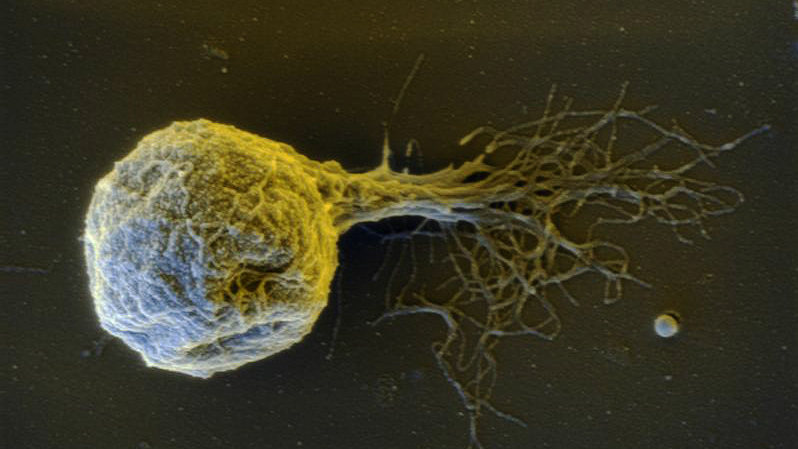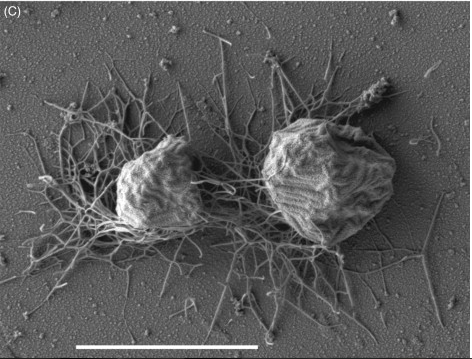Methanocaldococcus villosus
A Microbial Biorealm page on the genus Methanocaldococcus villosus
Classification

Higher order taxa
Archea; Euryarchaeota; Methanococci; Methanococcales; Methanocaldococcus; Methanocaldococcus villosus
Species
Methanocaldococcus villosus
Description and significance
Methanocaldococcus villosus is a chemolithoautotrophic, hyperthermophilic methanogen which was first discovered in a submarine hydrothermal system at the Kolbeinsey Ridge, north of Iceland. Cells of this archeal organism stained Gram-negative and appeared regular or irregular cocci in shape possessing more than 50 polar flagella. These cell appendages are used not only for motility but also allow the cell to adhere to non-living surfaces as well as make cell-cell connections. [2]
Genome structure
Based on its 16S rRNA gene sequence, the strain was found to belong to the order Methanococcales within the genus Methanocaldococcus; it shares approximately 95 % sequence similarity to the species Methanocaldococcus jannaschii making this its closest relative. [2] The genome size was determined to be in the range 1.8-2.0 kb, and the G-C content of the genomic DNA was 30 mol%. [2]
Cell and colony structure

The cell is covered with polar flagella (at least 50) and is known to be among the fastest organisms on the planet earth when put into scale. Their swimming speeds, with close to 400 and 500 bps (body lengths per second), are much higher than that of the bacterium Escherichia coli, or a very fast animal, like the cheetah, which are both around 20 bps. In addition two separate swimming modes were observed; cells either swim very rapidly, in a more or less straight line, or they exhibit a slower kind of zigzag swimming behavior. [3]
The two different types of motility (straight line and zig-zag) are used by the archaea to accomplish two different goals. When the cell is trying to reach an area more favorable in nutrition and temperature the cell will use the quicker, straight line movement. When the cell is seeking out a specific location for attachment it tends to use the zig-zag style of movement to locate and reach its destination. [3]
Metabolism
Methanogenesis is the main biochemical pathway from which Methanococcus villosus obtains energy.[2]
Ecology
M. villosus is able to grow in the temperature range of 55-90 °C, with optimum growth occuring at 80 °C. The optimum NaCl concentration for growth was 2.5 % (w/v), and the prime pH level is 6.5. [2] A translocation of just 1 cm through water current can be comparable to 10,000 body lengths for a bacterial cell of 1 μm in size (for a human, a similar change in location would be close to traveling 20 km), within such a distance, concentrations of potential food sources and temperature can vary to extremes. It is possible for temperature variations greater than 50°C within a distance of 1 cm in proximity of black smoker vent systems. Therefore, it is essential for this microorganism to be able to react to such differences by rapidly moving to more preferred surroundings and have a distinct advantage over bacteria that are immotile. [3]
References
1. "Ancient Bacteria Are Swimming Champions." Biotechnologie.de. Federal Ministry of Education and Research, 04 Feb. 2012. Web. 2 Mar. 2013.
2. Bellack, A., H. Huber, R. Rachel, G. Wanner, and R. Wirth. "Methanocaldococcus Villosus Sp. Nov., a Heavily Flagellated Archaeon That Adheres to Surfaces and Forms Cell-cell Contacts." National Center for Biotechnology Information. U.S. National Library of Medicine, 9 July 2010. Web. 2 Mar. 2013.
3. Herzog, B., and R. Wirth. "Swimming Behavior of Selected Species of Archaea." Swimming Behavior of Selected Species of Archaea. University of Regensburg, 29 Dec. 2011. http://pubmedcentralcanada.ca/pmcc/articles/PMC3298134/. 12 Mar. 2013.
Edited by Craig McClenaghan of BIO 311 taught by Dr. Lisa R. Moore, University of Southern Maine, Department of Biological Sciences, http://www.usm.maine.edu/bio
